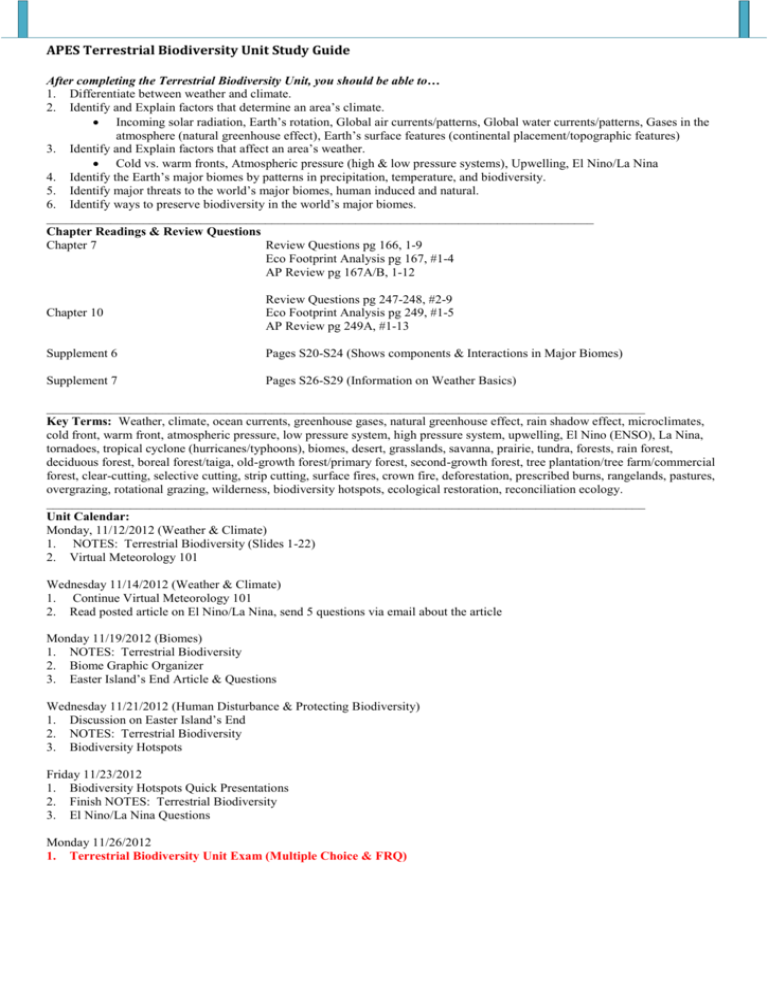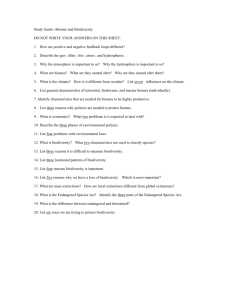APES Terrestrial Biodiversity Unit Study Guide
advertisement

APES Terrestrial Biodiversity Unit Study Guide After completing the Terrestrial Biodiversity Unit, you should be able to… 1. Differentiate between weather and climate. 2. Identify and Explain factors that determine an area’s climate. Incoming solar radiation, Earth’s rotation, Global air currents/patterns, Global water currents/patterns, Gases in the atmosphere (natural greenhouse effect), Earth’s surface features (continental placement/topographic features) 3. Identify and Explain factors that affect an area’s weather. Cold vs. warm fronts, Atmospheric pressure (high & low pressure systems), Upwelling, El Nino/La Nina 4. Identify the Earth’s major biomes by patterns in precipitation, temperature, and biodiversity. 5. Identify major threats to the world’s major biomes, human induced and natural. 6. Identify ways to preserve biodiversity in the world’s major biomes. _____________________________________________________________________________________ Chapter Readings & Review Questions Chapter 7 Review Questions pg 166, 1-9 Eco Footprint Analysis pg 167, #1-4 AP Review pg 167A/B, 1-12 Chapter 10 Review Questions pg 247-248, #2-9 Eco Footprint Analysis pg 249, #1-5 AP Review pg 249A, #1-13 Supplement 6 Pages S20-S24 (Shows components & Interactions in Major Biomes) Supplement 7 Pages S26-S29 (Information on Weather Basics) _____________________________________________________________________________________________ Key Terms: Weather, climate, ocean currents, greenhouse gases, natural greenhouse effect, rain shadow effect, microclimates, cold front, warm front, atmospheric pressure, low pressure system, high pressure system, upwelling, El Nino (ENSO), La Nina, tornadoes, tropical cyclone (hurricanes/typhoons), biomes, desert, grasslands, savanna, prairie, tundra, forests, rain forest, deciduous forest, boreal forest/taiga, old-growth forest/primary forest, second-growth forest, tree plantation/tree farm/commercial forest, clear-cutting, selective cutting, strip cutting, surface fires, crown fire, deforestation, prescribed burns, rangelands, pastures, overgrazing, rotational grazing, wilderness, biodiversity hotspots, ecological restoration, reconciliation ecology. _____________________________________________________________________________________________ Unit Calendar: Monday, 11/12/2012 (Weather & Climate) 1. NOTES: Terrestrial Biodiversity (Slides 1-22) 2. Virtual Meteorology 101 Wednesday 11/14/2012 (Weather & Climate) 1. Continue Virtual Meteorology 101 2. Read posted article on El Nino/La Nina, send 5 questions via email about the article Monday 11/19/2012 (Biomes) 1. NOTES: Terrestrial Biodiversity 2. Biome Graphic Organizer 3. Easter Island’s End Article & Questions Wednesday 11/21/2012 (Human Disturbance & Protecting Biodiversity) 1. Discussion on Easter Island’s End 2. NOTES: Terrestrial Biodiversity 3. Biodiversity Hotspots Friday 11/23/2012 1. Biodiversity Hotspots Quick Presentations 2. Finish NOTES: Terrestrial Biodiversity 3. El Nino/La Nina Questions Monday 11/26/2012 1. Terrestrial Biodiversity Unit Exam (Multiple Choice & FRQ)







